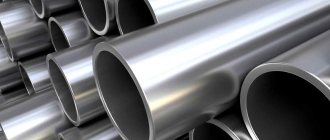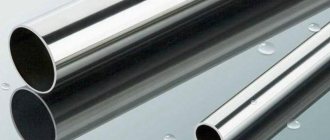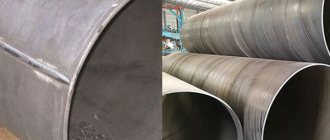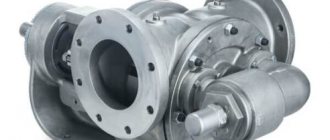Polishing stainless steel products makes them absolutely smooth and gives them a mirror shine. This type of metal processing refers to finishing operations and is performed only after all minor scratches, dents and other visible defects have been eliminated. During the polishing process, the smallest irregularities remaining after the previous grinding are cut off from the surface of stainless steel. In this case, the geometric dimensions of the part practically do not change, since the removed metal layer has a thickness of less than a micron.
Stainless steel is one of the most common structural materials. However, as a rule, it is used without anti-corrosion or decorative coatings - it is simply ground or polished. Mirrored panels of elevator cabins, shiny structures of stair railings, frames of stained glass windows, metal parts of escalators, sparkling medical equipment, kitchen utensils and household appliance housings - all this is stainless steel polished to a mirror.
Methods for polishing stainless steel
There are several technologies for polishing stainless steel, among which the most common are mechanical, chemical and their varieties. Mechanical is used to restore the mirror finish of stainless steel directly on site, as well as for workshop repairs and processing of small batches of products. When in-line processing of stainless steel parts at industrial enterprises, as a rule, the method of electropolishing in chemical solutions is used. You can bring stainless steel to a shine at home using methods and means available to everyone.
In case of minor damage or oxidation, the surface of a stainless steel product can be easily brought to a shine using polishing paste or chemical polishing reagents. If scratches and gouges on stainless steel are of a significant size, then mechanical grinding must first be performed.
Mechanical polishing
When mechanically polishing stainless steel, microprotrusions of the metal are cut off using abrasive grains. In this case, the tools used are circles, discs, rollers and tapes, and the abrasive materials are polishing pastes and suspensions. Some of them contain chemical components that, together with the abrasive, act on micro-irregularities. This type of processing is called chemical-mechanical polishing of stainless steel.
After machining or rolling, longitudinal stripes and grooves remain on the surface of stainless steel products. These irregularities, in the best case, have a roughness class of 6–7, so grinding stainless steel to class 8–10 is a prerequisite for preparing for the polishing operation, since classes 11–14 correspond to this type of processing.
Mechanical polishing of stainless steel can be done manually, without the use of power tools or special devices. This treatment is most common in everyday life and for small volumes of repair and restoration work. The following types of production equipment are used in production plants for polishing stainless steel:
- hand-held electric and pneumatic tools;
- polishing machines;
- drum and vibration devices;
- magnetic abrasive installations.
The most common abrasive materials for polishing stainless steel are various liquid polishes, suspensions and pastes, which allow you to achieve the best results in terms of roughness. Most of them are based on technical oils, fats and substances such as paraffin and stearin, which have to be removed from the surface of the stainless steel using organic solvents.
Electrochemical method
The technology of electrochemical polishing (ECP) of stainless steel is based on the process of movement of metal ions from the anode to the cathode. In general, such an installation consists of a metal bath with electrolyte connected to the negative pole of a direct current source (cathode). A stainless steel product is immersed in it, to which a positive potential is applied, i.e. it is the anode. When direct current is passed through the electrolyte, positive metal ions begin to detach from the surface of the stainless steel. To a greater extent, this occurs from the tops of microprotrusions, which are thus smoothed out (see figure below). The depth of metal removal during such chemical polishing of stainless steel in an electrolyte is regulated by the magnitude of the current and the duration of the process.
ECP allows you to process any hard-to-reach cavities and complex shaped elements by removing the same layer of metal over the entire surface of the product. Installations that perform chemical electropolishing of stainless steel operate at an electrolyte temperature of 70÷90 °C and a current density of 0.3 to 0.5 A/cm². Solutions based on a mixture of inorganic acids are used as electrolytes. For this reason, ECP is sometimes confused with chemical etching of metals and even nitric acid is mentioned in articles about them, although the main components of the electrolyte for stainless steel are phosphoric and sulfuric acids.
Production technologies
According to the production technology, a polished stainless steel pipe is practically no different from ordinary pipes. The only difference between them is the finishing treatment of the product after leaving the assembly line.
Thus, two types of pipe products are distinguished:
Welding method
The production of this type of product is carried out in accordance with the 1983 standard, where they are also called electric welded. However, although electricity is indeed used in this case, modern technologies are not exactly electric welding.
Among the methods for producing welded pipes are the following:
- laser welding;
- use of high-frequency induction currents for welding;
- welding in inert gas using tungsten electrodes. They create an electric arc that allows the metal to be heated to the melting temperature to join the edges of the workpiece;
- electron beam welding technology involves working in vacuum conditions, so it can be called the most exotic.
In general, the technological process consists of twisting the workpiece into a tube of the required diameter, welding it along the seam, further calibrating it in rollers and checking for tightness of the connection. Grinding of the stainless pipe is done at the very end.
Seamless production of stainless steel polished pipes
At the initial stage, using pressing or casting, a hollow round workpiece is produced, which, after careful processing and calibration in rollers, will become a finished pipe.
Based on the processing temperature, such pipes are divided into the following categories:
- cold-worked;
- heat deformed;
- hot-deformed.
Please note that according to GOST, the production technology of the last two types of pipes involves heat treatment. First, the pipes are heated, then allowed to cool to remove internal metal stresses. In this case, any violation of the technology will lead to deterioration in the quality of the pipe and loss of its strength.
Polishes
Most work on polishing piece goods and stainless steel metal structures is performed either manually or using a variety of power tools. In this case, a large number of polishing devices are used, among which the most common are:
- napkins, discs and circles made of non-woven fabric, felt and felt;
- rollers and disk packages;
- fan circles;
- polishing abrasive sheets and discs on paper and polymer base;
- non-woven materials with abrasive;
- polishing belts.
Hand-held power tools for polishing stainless steel, in addition to conventional polishing attachments, are equipped with devices for processing hard-to-reach places and curved surfaces. The main types of electrically driven tools used in stainless steel processing are:
- orbital sanders;
- grinders with various attachments and accessories;
- belt sanders;
- straight grinding power tools;
- portable belt sanders;
- band files with rotary attachments.
Various types of pastes are most often used as a polishing material for stainless steel, which are generally divided into materials for rough and final polishing. Based on the composition of their base, they are divided into water and fat. The latter hold abrasive material better, but are more difficult to remove from stainless steel. Auxiliary materials include microfiber cloths, which are used to clean the stainless steel surface after polishing.
How a polished stainless steel pipe is made, scope of application, dimensions
Popular in industrial and domestic construction, polished stainless steel pipes are distinguished by high quality, wear resistance, reliability, long service life and aesthetic appeal. This material will discuss materials and standards for the manufacture of polished stainless steel pipes, as well as areas of its active application.
An easy way to polish stainless steel at home
Polishing stainless steel at home is easy. It all depends on how damaged and oxidized the object being polished is, as well as on the presence of hard-to-reach places. If the stainless steel surface has simply lost its shine due to oxidation, you can use chemical polishing with vinegar, olive oil or special branded products. To do this, you just need to apply one of these substances to a microfiber cloth, then work it on all sides with smooth circular movements. This way you can restore the shine of kitchen equipment, dishes, as well as stainless pipes in the bathroom.
To polish stainless steel products to a mirror shine at home, GOI paste is usually used. Polishing is done using felt or felt. After completion, all surfaces must be cleaned using a microfiber cloth moistened with a small amount of solvent.
Both of these methods are suitable in cases where the stainless steel is not significantly damaged. If there are scratches, gouges and a large amount of plaque before polishing, you will have to mechanically grind the stainless steel (manually or using a power tool).
What prevents steel from rusting
When chromium interacts with oxygen, a protective film is formed on the surface of stainless steel; it is this film that protects the alloy from exposure to aggressive environments.
The amount of chromium will determine the degree of corrosion resistance of steel.
For example, in the manufacture of refrigerators, an alloy with an average chromium content (10-17%) is used. But if the device is constantly in contact with water or is subjected to temperature loads, then an alloy with a high chromium content, up to 26%, is used. Such appliances include washing machines, dishwashers, sinks, hoods, cookers and kettles.
Frequency and methods of caring for stainless steel
In order for the surface of stainless steel products to remain smooth and glossy for as long as possible, when cleaning it, it is necessary to avoid the use of abrasive pastes, steel wool, hard sponges and brushes, as well as chlorine-containing substances. In the absence of significant damage, a smooth matte film of chromium oxide forms on the surface of the stainless steel, which protects the base metal from corrosion and prevents scale from sticking to it. The need for periodic polishing arises as wear and external damage appears on the stainless steel, and its need is determined by visual inspection.
There are articles on the Internet about cleaning stainless steel products (in particular thermoses, dishes, etc.) using Coca-Cola. It is known that this drink contains orthophosphoric acid. But there is such a tiny amount of it in Coca-Cola that the very possibility of such processing of stainless steel raises natural doubts. What do you think about this? Have you ever cleaned stainless steel items with Coca-Cola or something similar? Please share your opinion and experience in the comments to this article.
To come in
Already registered? Sign in here.
There are currently 0 users on the page
There are no users viewing this page.
Stainless steel comes in different varieties. After all, it contains several different metals. The basis of stainless steel is iron, titanium, nickel, molybdenum, manganese, and this is not the entire list. Chromium, which is also present in its composition, helps this steel resist corrosion.
Read also: Turning on a wood lathe
Methods and means for polishing stainless steel coatings
The smooth surface of the metal gets damaged when handled carelessly due to deliberate human actions. Not every mark can be removed with stainless steel polish and a soft rag. In a home workshop (garage), many methods are available for processing volumetric, flat, and curved surfaces of alloy alloy products. It is necessary to have the appropriate equipment and reagents.
Areas of use
Polished stainless steel pipes are purchased mainly because of their external beauty, since they are often used for decorative purposes.
Very often such products are used in the following cases:
- Furniture manufacturing. For example, frames for chairs and beds, parts for mobile furniture, various racks and supports. Such decorative elements can withstand many years of use without loss of shine and beauty, which, for example, chrome-plated pipes are not capable of.
Grinding with mechanical polishing
After damaging metal processing (cutting, welding, drilling, cleaning with hard rotary brushes, impacts), defects of various sizes are formed:
- scratches, dents;
- seams, sagging, shells;
- chips;
- cracks;
- burrs.
These surface deteriorations reduce wear resistance, reflectivity, and resistance to complex loads. To eliminate roughness and add shine to such a hard material as stainless steel, you will have to perform 4–5 operations. Grinding is carried out using an electric grinder and replaceable abrasive wheels. With a felt/felt circle, after rough cleaning, they begin to polish the product. The endless belt makes it easy to process complex stainless steel parts.
For rough grinding of stainless steel, abrasive grit 30-40, finishing 16 - 25, polishing with micropowders with grit M7 - M14, finishing to a mirror - industrial ready-made compounds (polishes).
The mechanical action of a soft circle with applied paste removes a very small amount of metal. Glossy leveling occurs due to the redistribution of the structure of the top layer of stainless steel, rather than cutting it off. Under the influence of air, active components of the paste, and heating from friction, old oxide films are destroyed and, immediately, upon cooling, new ones are created.
After mechanical polishing, ideal smoothness and, accordingly, shine in inconvenient places is not created. In this case, finish polishing by hand. Bringing a mirror finish to stainless steel by hand is a labor-intensive, time-consuming operation, but doable. The creation of a mirror begins with polishing pastes and ends with liquid polishes.
Mechanical method of polishing stainless steel
It is necessary to subject the entire visible plane to the process - partial local processing will be noticeable. Visible differences cannot be eliminated by using polish.
Chemical method
Small stainless steel parts are processed using a method that does not require much physical effort and several hours of work. Using circles can just be awkward. Immerse the cleaned workpiece in a bath with strictly dosed reagents, diluted to the required concentration with distilled water. Over a sufficient period of time, under the influence of caustic reagents, all steel roughness in contact with the liquid active medium is eliminated. Deep scratches and welding marks are first leveled with emery wheels, then smoothed with soft circles with paste of the required grain size (GOI). Otherwise, all large flaws will also be polished while maintaining their shape.
To correctly select components and their concentration in the water mass, it is advisable to know the grade of stainless steel:
- Brand X18N9T is immersed in the following composition: acids: 230 ml sulfuric, 40 ml nitric, 70 ml hydrochloric. To 1 liter of solution add acid black dye - 6 g, wood glue - 10 g, sodium chloride - 6 g. The liquid temperature is maintained at 65-70 ° C, time 5÷30 minutes.
- Acids in proportion to the total volume: nitric 4÷5%, orthophosphoric 20÷30%, hydrochloric 3÷4%, methyl orange - 1÷1.5%, in an aqueous solution with a temperature of 18÷25 ° C, Approximate holding time 5÷ 10 min .
- Per liter of composition the amount of acids: sulfuric 230 g, hydrochloric 660 g, orange acid dye - 25 g. Maintain a temperature of 70÷75 ° C, time 2÷3 minutes.
To complete the reaction at all points and remove the resulting products, the liquid in the container is continuously stirred. You can move the steel part.
The components are aggressive. Provide protection for the skin of the hands, face, eyes, and respiratory organs.
Chemical alignment of the line of the outer boundary of the stainless steel (polishing) occurs because the reaction is more intense on the protrusions of the profile. To prevent the accumulation of interaction products in depressions, recesses, and corners, fluid movement is forced. After washing off the chemical reagents, rub with a napkin with a small amount of polish.
Anode method
Electrochemical treatment reduces the time spent in relation to the mechanical procedure by 4-5 times, increasing the cleanliness class of the mirror by 1 or 2 positions. To polish in this way, the complexity of the joints and the curvature of the planes become unimportant. When electricity is connected, the solution becomes an active electrolyte, interacting more intensely. The sample being processed must be connected to the anode of the installation. For each chemical composition of stainless steel, reagents and mode parameters are selected.
Cleaning the hood
This is not an easy task. But quite doable. To prevent dirt and soap from staining the stove, it is better to cover it with newspapers or old towels.
To clean the hood, you can use a specialized product or prepare a solution yourself. You will need bicarbonate of soda, lemon juice and water. The product must be rubbed in carefully so as not to damage the surface. It is enough for the solution to remain on the hood for several minutes, after which it must be washed off with clean running water. Next, you need to polish the surface well with a dry cloth. After this procedure, the hood will shine like new.
Plasma polishing
The technology differs from the electrochemical procedure in the following parameters:
- the solution is not aggressive, disposal does not require special cleaning;
- voltage is higher (220 V);
- temperature is about 100 °C.
The reagent used is ammonium salt with a concentration in the solution of 3.1 ÷ 6.0%. The electric current density is set at 0.35 ± 0.15 A/cm²; gas bubbles are intensively formed in the contact zone of the electrolyte with the stainless steel. Discharges occur in the vapor inside the fluidized bed, ionizing the medium. Plasma tongues appear that specifically act on the steel, polishing it. The time required for one dive is within 6 minutes, based on a power consumption of 5 Wh/cm².
For a stable process of polishing a surface of a certain area using the electroplasma method, the appropriate power of the installation is required. You cannot reduce its value in the hope of increasing the duration of treatment in the bath. The conditions for the formation of a plasma-ionized layer will not be met.
Unscrupulous mechanical preparation will be evident. Residual traces of welds, scratches, and dents cannot be hidden with polish.
Standard sizes
The standards used for the manufacture of polished stainless steel pipes are similar to other products made from corrosion-resistant steels:
- According to GOST 9940-81, hot-deformed seamless pipes are produced with a cross-section of 57-325 mm and a wall thickness in the range of 3.5-32 mm.
- Cold- and heat-deformed seamless pipes in accordance with GOST 9941-81 can have a diameter in the range of 5-273 mm, and the wall thickness ranges from 0.2-22 mm.
- According to GOST 11068-81, the diameter of welded pipes can reach 8-102 mm with a wall thickness of 0.8-4 mm.
It is worth noting that the greatest demand is still for thin-walled pipes, which are characterized by wear resistance, reliability and attractive appearance. Most of these polished stainless steel pipes are produced by welding.










